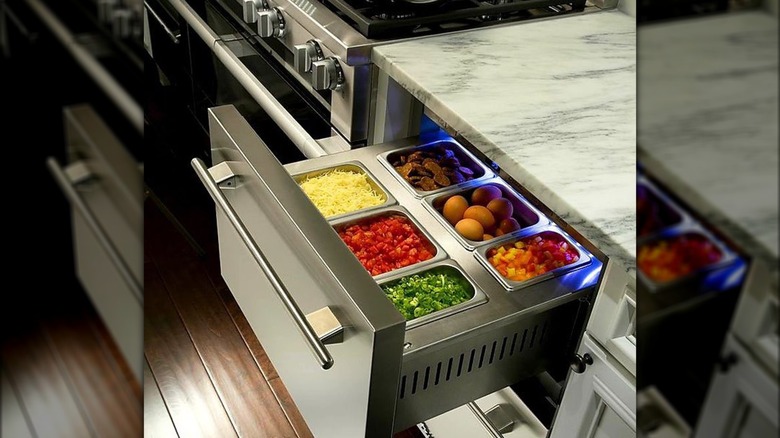Refrigerated Drawers Are As Fancy As They Sound (And Keep Your Food Extra Fresh)
Considering the near-constant fanfare about technology evolving to improve the world, it's a shame that refrigerators appear to have been left behind, basically only one step up from being a hole in the ground. The electric refrigerators using compressed gas we know today started to become mainstream in homes from the late 1920s, but little has changed since then apart from their price — original refrigerators cost the equivalent of over $6,500 in today's money. Other than that, they're still as big, heavy, and ugly as they've always been.
It's for those reasons that nobody longs to scroll through Instagram photos of refrigerators in the morning, opting instead for glamorous shots of puppies and smashed avocado. But this could be about to change, as refrigerators might finally be catching up with the future — and it's all thanks to refrigerated drawers. You don't need a degree from Yale to work out that these fit under worktops like regular kitchen drawers, but are chilled to keep food cool. The question is: Are they any good?
Refrigerated drawers are sleek but expensive
With their sleek stainless steel or wood-effect designs, refrigerated drawers have the appearance of a futuristic appliance sourced directly from the intergalactic world of "Star Trek" — think of them as sock drawers for your food. In fact, they have existed since at least the late 1990s, but they were thrown into the current consciousness by a viral Twitter post showing eggs, sliced cheese, meat, and vegetables neatly tucked into separate compartments inside an under-the-counter drawer.
Although this specific setup has been mocked by internet users for looking like a Subway counter, it demonstrates that the drawers are ergonomic, practical, and aesthetically pleasing. The small size of refrigerated drawers is seen as particularly beneficial to young children (unless you're trying to stop them from accessing fistfuls of cheese at any given time) and can therefore be considered more accessible than a conventional standing refrigerator. Drawers in some models can also be used as freezers.
Because they're designed for sliding under kitchen worktops, the small size of refrigerated drawers conversely means there is limited storage space, and they are generally only available individually or in twos. As a result, they're generally considered to be an addition to a conventional refrigerator rather than a replacement, meaning cost is a significant drawback: Prices can range from around $1,900 to nearly $4,000. Maybe a hole in the ground isn't such a bad idea after all.

